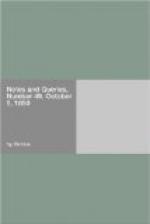“Several of his [Gray’s] pieces were published, 1753, with designs by Mr. Bentley, and that they might in some form or other make a book, only one side of each leaf was printed. I believe the poems and the plates recommended each other so well, that the whole impression was soon bought.”
It contains six poems, one being the Elegy. I have before me a copy of this collection, which is folio. The plates are clever, and very curious; a copy was sold at the Fonthill sale for 3l. 4s.! The copy, admirably bound, which I quote, was bought at a bookseller’s front-window stall for 4s. The title of this collection is “Designs by Mr. R. BENTLEY, for six poems by Mr. J. GRAY.”
According to the title-page, it was “printed for R. DODSLEY, in Pall Mall, MDCCLIII.,” two years previously to the date to which your correspondent refers. This (1753) collection gives the line,—
“Save where the beetle wheels his droning flight.”
In the Elegant Extracts (verse), ed. 1805, which, it must be needless to mention, was prepared by the able and indefatigable Dr. Vicesimus Knox, the accomplished scholar gives the line—
“Save where the beetle wheels his drony flight.”
Dr. Johnson’s Dictionary does not insert the word “droning” or “drony;” but among his Illustrations attached to the verb “to drone,” there are two from Dryden, each, it may be seen, using the word “droning.” There is no quotation containing the word “drony.” Gray’s language is:
“Save where the beetle wheels his
droning flight,
And drowsy tinklings lull
the distant folds.”
Johnson’s second quotation from Dryden may be worth repeating, as showing that Gray’s language is not wholly different from his predecessor’s:—
“Melfoil
and honeysuckles pound,
With these alluring savours strew the
ground,
And mix with tinkling brass the
cymbal’s droning sound.”
It is perhaps hardly worth noticing, that there is not uniformity even in the title. Johnson calls it, Elegy in the Church-yard; Dodsley (1753) styles it, Elegy written in a Country Church-yard.
A HERMIT AT HAMPSTEAD.
Gray’s Elegy (Vol. ii., p. 264.).—The HERMIT OF HOLYPORT is referred to the 4to. edit. of the Works of Gray, by Thos. Jas. Mathias, in which, vol. i. at the end of the Elegy, in print, he will find “From the original in the handwriting of Thos. Gray:
“‘Save where the beetle wheels his droning flight.’”
From the autograph the Elegy appears to have been written in 1750; and the margin states, published in Feb. 1751, by Dodsley, and went through four editions in two months; and afterwards a fifth, sixth, seventh and eighth, ninth and tenth, and eleventh; printed also in 1753, with Mr. Bentley’s designs, of which there is a second edition; and again by Dodsley in his Miscellany, vol. iv.; and in a Scotch collection, called the Union. Translated into Latin by Chr. Anstey, Esq., and the Rev. Mr. Roberts, and published in 1762; and again in the same year by Rob. Lloyd, M.A. The original MS. of the above will be found among the MSS. of Thos. Gray, in the possession of the Masters and Fellows of Pembroke House, Cambridge.




